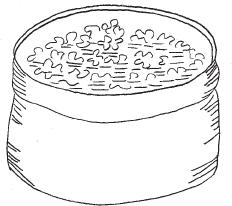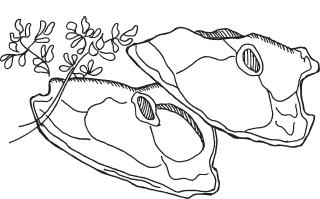Nourishing Traditions: The Cookbook That Challenges Politically Correct Nutrition and The... (90 page)
Authors: Sally Fallon,Pat Connolly,Phd. Mary G. Enig
Tags: #Non-Fiction, #Reference, #Science, #Health

The physiques of the Indians of the far north who are still living in their isolated locations and in accordance with their accumulated wisdom were superb. There were practically no irregular teeth including no impacted third molars, as evidenced by the fact that all individuals old enough to have the molars erupted had them standing in position and functioning normally for mastication. . .. Where the Indians were using the white man's food tooth decay was very severe. . .. In the new generation, after meeting the white civilization and using his foods, many developed crooked teeth, so-called, with deformed dental arches. Weston Price, DDS
Nutrition and Physical Degeneration

VENISON STEW
Serves 6
3 pounds venison, cut into 1-inch cubes
2 cups red wine
2 tablespoons butter
2 tablespoons extra virgin olive oil
4 cups
beef
or
venison stockseveral sprigs fresh thyme, tied together
2 cloves garlic, peeled and mashed
8 juniper berries
½ teaspoon dried green peppercorns, crushed
several small pieces lemon rind
1 rutabaga, peeled and cut into ½ inch cubes
1 pound pearl onions, peeled and sauteed in butter
1 cup spinach or kale, chopped
2 tablespoons arrowroot mixed with 2 tablespoons filtered water
sea salt and pepper
Marinate venison cubes in wine for several hours at room temperature or overnight in the refrigerator. Remove meat and dry well with paper towels, reserving marinade.
In a heavy flameproof casserole, brown the venison cubes, a few at a time, in butter and olive oil. Transfer with a slotted spoon to a plate. Pour out browning fat and pour wine marinade into the pan. Bring to a boil, stirring with a wooden spoon to scrape up any accumulated juices. Add stock, bring to a boil and skim. Add thyme, garlic, juniper berries, peppercorns and lemon rind. Return meat to casserole, cover and bake in the oven at 350 degrees for several hours. About 45 minutes before serving, add the rutabaga.
When rutabaga is tender, transfer casserole to the stove. Spoonful by spoonful, add the arrowroot mixture to the stew while it simmers, until sauce reaches desired thickness. Season to taste. Add the onions and kale and simmer a few minutes more.
The [Pima] Indians are especially fond of squirrels or any game. The old folks say that the reason the tribe is dying is because they are compelled to eat beef and flour instead of fish, game, acorns, buckeyes, wild bulbs and tubers, shell fish and seaweed, salt from the ocean and sugar from the pine tree.
Grace Hudson
VENISON CHOPS
Serves 6
6 venison chops
2 cups red wine
1 teaspoon grated orange peel
1 teaspoon dried thyme
2 tablespoons butter
2 tablespoons extra virgin olive oil
2 cups
beef
or
venison stockjuice of 1 orange
2 tablespoons arrowroot mixed with 2 tablespoons filtered water
sea salt and pepper
Marinate the chops in a mixture of the wine, orange peel and thyme for several hours at room temperature or overnight in the refrigerator. Dry cutlets well and reserve marinade.
In a heavy skillet, brown the chops, two at a time, in butter and olive oil, about 5 minutes per side. Transfer to a plate while browning the remaining chops. Pour off browning fat and pour marinade into the pan. Bring to a boil, stirring with a wooden spoon to scrape up any accumulated juices in the pan. Add stock and orange juice, bring to a boil and skim.
Add the chops to the liquid, reduce heat, cover and cook about 1 hour. (If chops are from a young deer, and very tender, this step will not be necessary. They can be eaten medium rare.) Remove to a heated platter and keep warm in oven while finishing sauce. Bring sauce to a rapid boil and reduce to about half. Add the arrowroot mixture, spoonful by spoonful, until desired thickness is obtained. Season to taste and serve.
It is significant that while these important factors are just coming to light in our modernized civilization, the evidence clearly indicates that several so-called primitive races have been conscious of the need for safeguarding motherhood from reproductive overloads, which would reduce the capacity for efficient reproduction. For example, G. T. Gaden in his book
Among the Ibos of Nigeria
states: It is not only a matter of disgrace but an actual abomination, for an Ibo woman to bear children at shorter intervals than about three years. . .. The idea of a fixed minimum period between births is based on several sound principles. The belief prevails strongly that it is necessary for this interval to elapse in order to ensure the mother being able to recuperate her strength completely and thus be in a thoroughly fit condition to bear another child. Should a second child be born within the prescribed period the theory is held that it must inevitably be weak and sickly, and its chances jeopardized.
Similarly, the Indians of Peru, Ecuador and Columbia have been familiar with the necessity of preventing pregnancy overload of the mother. Whiffen in his book
North-West Amazona
states: The numbers (of pregnant women) are remarkable in view of the fact that husbands abstain from any intercourse with their wives, not only during pregnancy but also throughout the period of lactation—far more prolonged with them than with Europeans. The result is that two and a half years between each child is the minimum difference of age, and in the majority of cases it is even greater.
It may also be important to note that the Amazon Indians have been conscious of the fact that these matters are related to the nutrition of both parents. Whiffen states that: These Indians share the belief of many peoples of the lower cultures that the food eaten by the parents—to some degree of both parents—will have a definite influence upon the birth, appearance or character of the child.
This problem of the consciousness among primitives of the need for spacing children has been emphasized by George Brown in his studies among Melanesians and Polynesians in which he reports relative to the native on one of the Solomon Islands as follows: After the birth of a child the husband was not supposed to cohabit with his wife until the child could walk. If a child was weak or sickly, the people would say, speaking of the parents, "Ah, well, they have only themselves to blame." Weston Price, DDS
Nutrition and Physical Degeneration

WILD DUCK STEW
Serves 6-10
4 wild ducks
2 cups dry white wine or vermouth
4 tablespoons duck fat (
Duck Fat and Cracklings
)2 medium onions, peeled and finely chopped
2 carrots, peeled and finely chopped
1 red pepper, seeded and chopped
¼ cup red wine
3-4 cups
duck stockseveral sprigs fresh thyme, tied together
½ teaspoon dried green peppercorns, crushed
2 tablespoons arrowroot mixed with 2 tablespoon filtered water
1 pound pearl onions, sauteed in butter
sea salt and pepper
Cut the ducks into parts. (See
Duck Fat and Cracklings
.) Use the carcass, including the feet and heads, to make
duck stock
. Marinate the wing, leg, thigh and breast pieces in wine for several hours at room temperature or overnight in the refrigerator.Dry pieces well with paper towels. Prick skin all over with a sharp needle—this will allow fat to drain out during the browning process. Place duck pieces skin side up in a stainless steel baking dish and brown in a 400 degree oven for about ½ hour until skin becomes golden. Meanwhile, saute onions, carrots and pepper gently in a heavy flameproof casserole in duck fat. Add wine marinade, stock and red wine. Bring to a boil, skim and reduce liquid to about half. Add the duck pieces, thyme and seasonings. Cover and bake at 300 degrees for several hours.
Remove from oven and set casserole over a low flame. Add the arrowroot mixture, spoonful by spoonful, until desired thickness is obtained. Season to taste. Add the onions and serve.
The newcomers to 16th-century Ireland brought with them not merely their farming methods and their money but also their prejudices and their tastes. The consumption of blood, in a jellified form or mixed with butter, oats or salt, was an aspect of Gaelic cuisine that particularly repelled English observers. They were appalled, too, by the willingness of the native population to devour animal entrails and to eat carrion and horse meat, by their partiality for warm milk straight from the cow, adorned with straw and worse, by their habit of eating rancid butter, by their unhopped ale and by their preference for oatcakes and gruels rather than good wheaten bread. S. J. Connolly
The Oxford Companion to Irish History
DUCK STEW WITH DRIED CHERRIES
Serves 6-10
3 wild ducks
2 cups red wine
4 cups
duck stockseveral sprigs fresh thyme, tied together
½ teaspoon dried green peppercorns, crushed
several small pieces orange rind
8 ounces dried cherries
2 tablespoons arrowroot mixed with 2 tablespoons filtered water
sea salt and pepper
Cut the ducks into parts. (See
Duck Fat and Cracklings
.) Use the carcass, including the feet and the heads, to make
duck stock
. Marinate the wing, leg, thigh and breast pieces in wine for several hours at room temperature or overnight in the refrigerator.Dry pieces well with paper towels. Prick skin all over with a sharp needle—this will allow fat to drain out during the browning process. Place duck pieces skin side up in a stainless steel baking dish and brown in a 400-degree oven for about ½ hour until skin becomes golden. Remove duck pieces to a flameproof casserole. Pour duck fat out of baking pan and pour in wine marinade. Bring to a boil, stirring with a wooden spoon to scrape up any accumulated juices in the pan. Add stock, bring to a boil and skim. Boil vigorously until liquid has reduced by about half. Add the thyme, peppercorns, orange rind and cherries. Pour sauce over duck pieces, cover casserole and bake at 300 degrees for several hours.
Remove from oven and set casserole over a low flame. Add the arrowroot mixture, spoonful by spoonful, until desired thickness is obtained. Season to taste.
